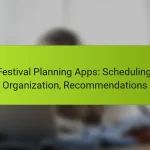Social justice movements are increasingly shaping festival lineups, with a focus on diversity and inclusion among artists. This evolution not only amplifies underrepresented voices but also influences audience perceptions and responses, ultimately impacting future programming decisions. By prioritizing inclusive practices, festivals can foster a more equitable music industry that reflects a broader spectrum of talent and community engagement.

How do festival lineups reflect social justice movements?
Festival lineups increasingly showcase social justice movements by prioritizing diversity and inclusion among artists. This shift aims to amplify underrepresented voices and foster a more equitable music industry.
Inclusion of diverse artists
Inclusion of diverse artists in festival lineups is essential for reflecting the broader cultural landscape. Festivals are increasingly curating lineups that feature musicians from various backgrounds, including different races, genders, and sexual orientations. This not only enriches the festival experience but also signals a commitment to social justice.
For example, festivals like Coachella and Glastonbury have made concerted efforts to include artists from underrepresented groups, often resulting in lineups that feature a significant percentage of female and [censured] performers. This trend is not just a marketing strategy; it represents a shift in the industry towards greater equity.
Representation of marginalized communities
Representation of marginalized communities in festival lineups is crucial for fostering inclusivity and awareness. By featuring artists from these communities, festivals can highlight social issues and cultural narratives that might otherwise be overlooked. This representation can empower these artists and provide them with a platform to share their stories.
Moreover, festivals that prioritize marginalized voices often create partnerships with community organizations, enhancing their impact. For instance, some festivals collaborate with local advocacy groups to ensure that the artists they feature resonate with the community’s values and struggles.
Impact on audience perception
The impact of diverse festival lineups on audience perception is significant. Audiences are increasingly aware of social justice issues and often respond positively to festivals that reflect these values. A lineup that prioritizes diversity can enhance the festival’s reputation and attract a broader audience.
Furthermore, audiences may feel more connected to the festival experience when they see representation that reflects their own identities. This connection can lead to increased engagement, loyalty, and even advocacy for social justice causes, as attendees recognize the importance of supporting inclusive practices in the music industry.

What are the audience responses to festival lineups?
Audience responses to festival lineups often reflect their views on diversity and representation among performers. These reactions can significantly influence future lineups and the overall perception of the festival.
Engagement on social media
Social media serves as a primary platform for audiences to express their opinions on festival lineups. Fans often share their excitement or disappointment through posts, comments, and hashtags, which can quickly amplify their sentiments. Festivals that receive positive engagement may see increased ticket sales and brand loyalty.
For example, a festival lineup featuring a diverse range of artists may generate enthusiastic discussions and shares, while a lineup perceived as lacking representation might lead to criticism and calls for change. Monitoring these trends can provide valuable insights into audience preferences.
Attendance trends
Attendance at festivals can be directly influenced by the lineup’s perceived inclusivity. Festivals that prioritize diverse representation often experience higher attendance rates, particularly among younger audiences who value social justice. Conversely, lineups that are seen as homogenous may deter potential attendees.
For instance, festivals that feature a mix of genres and artists from various backgrounds may attract a wider audience, while those with a narrow focus might see a decline in ticket sales. Tracking attendance data can help organizers understand the impact of their lineup choices.
Feedback on representation
Feedback regarding representation in festival lineups is increasingly vocal and impactful. Audiences are more likely to scrutinize the diversity of performers, calling for gender balance and representation of various ethnicities and backgrounds. This feedback can shape future programming decisions.
Festivals that actively seek and respond to audience feedback on representation often enhance their reputation and foster community support. Organizers should consider conducting surveys or engaging in discussions to gauge audience expectations and improve future lineups accordingly.
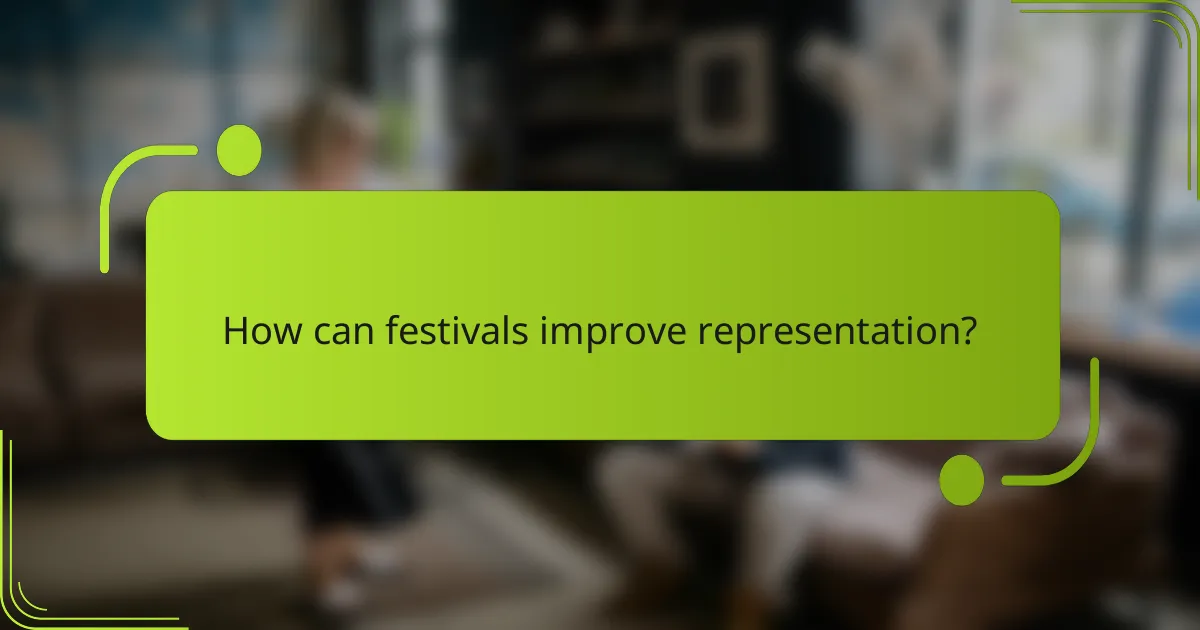
How can festivals improve representation?
Festivals can enhance representation by adopting inclusive practices that prioritize diversity in their lineups and planning processes. This involves actively seeking out underrepresented artists and engaging with local communities to ensure a broader range of voices is heard.
Diverse booking practices
Diverse booking practices involve selecting artists from various backgrounds, genres, and demographics. Festivals should aim for a balanced lineup that reflects the community’s diversity, which can include considerations of race, gender, and cultural representation.
To implement this, organizers can establish quotas or guidelines for representation, ensuring that at least a certain percentage of performers come from underrepresented groups. Regularly reviewing past lineups can also help identify gaps and opportunities for improvement.
Community involvement in planning
Engaging the community in the planning process is crucial for improving representation at festivals. This can be achieved by forming advisory boards that include local artists, activists, and community leaders who can provide insights and feedback on programming decisions.
Organizers can host public forums or surveys to gather input from the community, ensuring that the festival reflects the interests and needs of its audience. This collaborative approach fosters a sense of ownership and investment in the event.
Transparency in selection criteria
Transparency in selection criteria helps build trust between festival organizers and the community. Clearly outlining how artists are chosen for the lineup can demystify the process and encourage broader participation from diverse groups.
Festivals should publish their selection criteria on their websites and communicate any changes to these guidelines. This openness allows potential performers to understand how they can align with the festival’s goals and increases the likelihood of a more varied lineup.
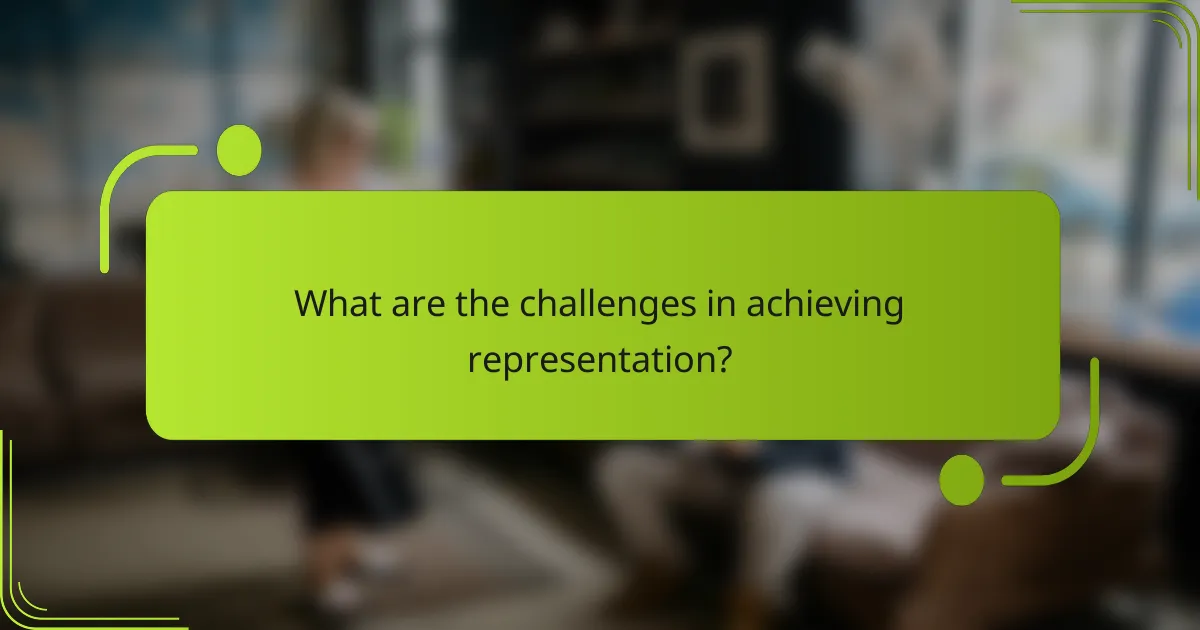
What are the challenges in achieving representation?
Achieving representation in social justice movements, particularly in festival lineups, faces several significant challenges. These include industry biases, financial constraints, and a lack of comprehensive data on diversity, all of which can hinder equitable participation and visibility.
Industry biases
Industry biases often manifest in the selection processes for festival lineups, where established names and traditional genres dominate. This can lead to underrepresentation of marginalized groups, as decision-makers may unconsciously favor familiar artists over diverse talent. Addressing these biases requires a conscious effort to include a wider range of voices and perspectives.
To combat industry biases, festivals can implement blind selection processes or diversify their programming committees. This ensures that a variety of artists are considered, promoting inclusivity and representation across genres and backgrounds.
Financial constraints
Financial constraints play a crucial role in limiting representation at festivals. Smaller or emerging artists often lack the financial backing to participate, which can skew lineups towards more commercially viable acts. Festivals may prioritize higher-paying artists, inadvertently sidelining diverse talent that may not yet have mainstream recognition.
To mitigate financial barriers, festivals can establish grant programs or partnerships with sponsors dedicated to supporting underrepresented artists. Offering lower fees or providing financial assistance can help create a more balanced lineup that reflects diverse voices.
Lack of data on diversity
The lack of reliable data on diversity within the music industry complicates efforts to achieve equitable representation. Without comprehensive statistics on artist demographics, it is challenging to assess progress or identify gaps in representation. This absence of data can lead to a cycle of underrepresentation, as festivals may not recognize the need for change.
To improve this situation, industry stakeholders should prioritize collecting and sharing demographic data on artists and festival lineups. Establishing benchmarks for diversity can help festivals set goals and track their progress over time, fostering a more inclusive environment for all artists.
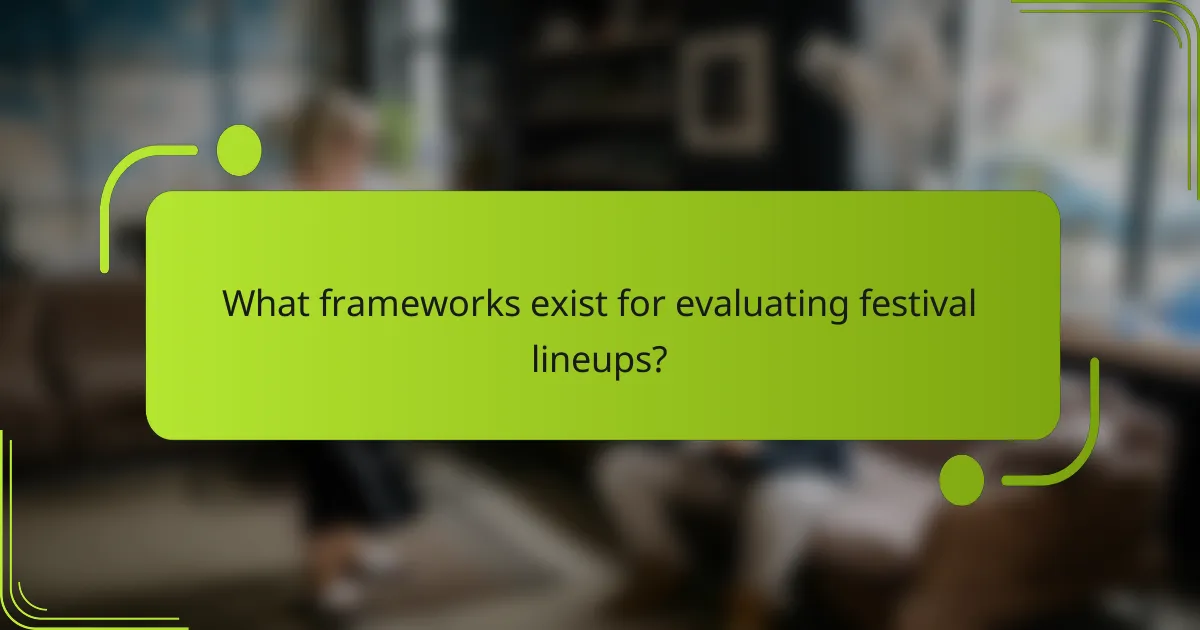
What frameworks exist for evaluating festival lineups?
Evaluating festival lineups involves various frameworks that assess representation, diversity, and audience engagement. These frameworks help organizers understand the inclusivity of their events and the demographic makeup of performers and attendees.
Equity assessment tools
Equity assessment tools are designed to measure the fairness and representation of artists in festival lineups. These tools often include metrics that evaluate gender, ethnicity, and other demographic factors among performers. For instance, a common approach is to analyze the percentage of female artists compared to male artists, aiming for a balanced representation.
When using these tools, consider the context of the festival’s location and its audience. For example, a festival in a region with a diverse population should reflect that diversity in its lineup. Regularly updating these assessments can help track progress over time and identify areas for improvement.
Audience demographic analysis
Audience demographic analysis focuses on understanding the characteristics of festival attendees. This includes collecting data on age, gender, ethnicity, and socioeconomic status to gauge how well the lineup resonates with different groups. Surveys and ticket sales data can provide insights into who is attending and whether the lineup meets their expectations.
To conduct effective audience demographic analysis, festivals should employ a mix of qualitative and quantitative methods. For example, combining survey responses with ticket purchase patterns can reveal trends in audience preferences. This analysis can guide future lineups, ensuring they cater to a broader audience while promoting inclusivity and representation.
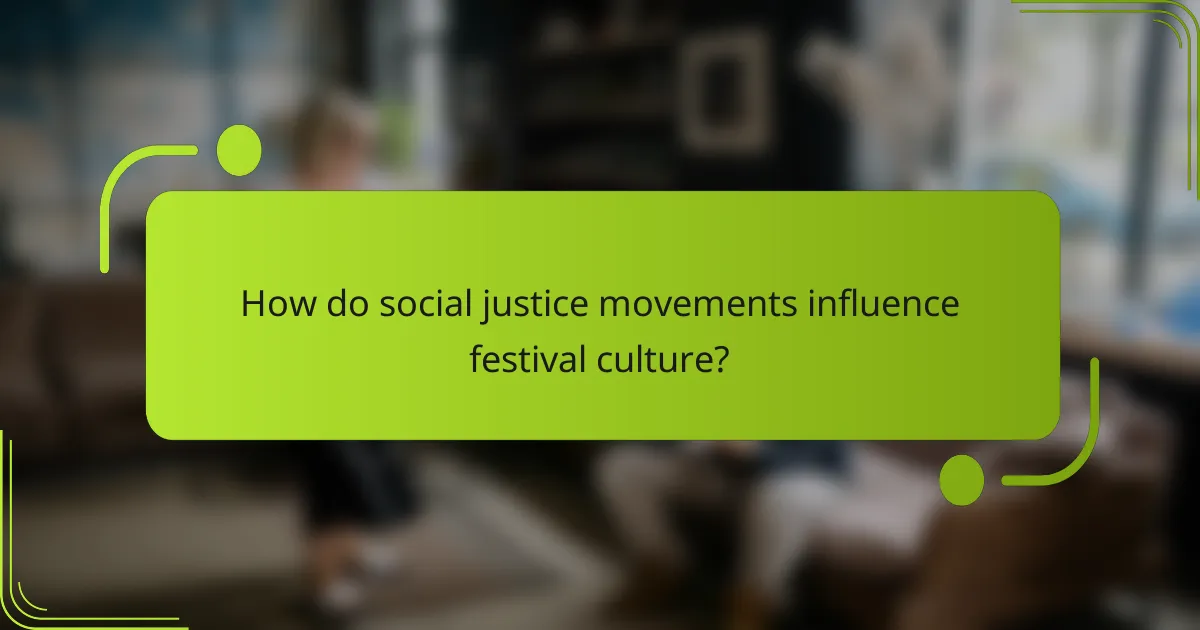
How do social justice movements influence festival culture?
Social justice movements significantly shape festival culture by driving changes in representation, programming, and audience engagement. These movements encourage festivals to prioritize diversity and inclusivity, reflecting broader societal values and expectations.
Shifts in audience expectations
As social justice movements gain momentum, audience expectations for festival lineups have evolved. Attendees increasingly seek diverse representation across gender, race, and sexual orientation, pushing organizers to curate more inclusive lineups.
This shift often translates into higher demand for artists from underrepresented communities, prompting festivals to rethink their booking strategies. For example, festivals that fail to meet these expectations may face backlash or decreased attendance.
Emergence of activist festivals
The rise of social justice movements has led to the emergence of activist festivals that focus on advocacy and community engagement. These festivals often feature panels, workshops, and performances that address pressing social issues, creating a platform for dialogue and action.
Examples include festivals that center on climate justice, racial equality, or [censured] rights, where the programming is designed not just for entertainment but also for education and mobilization. Such events often foster a sense of community and purpose, attracting attendees who are passionate about social change.

What are the future trends in festival representation?
Future trends in festival representation are increasingly focused on diversity and inclusivity. Organizers are prioritizing a broader range of artists and voices, reflecting the demographics of their audiences and communities.
Increased Diversity in Lineups
Festivals are moving towards more diverse lineups that include artists from various backgrounds, including race, gender, and sexual orientation. This shift not only enhances the cultural richness of the events but also attracts a wider audience. For instance, festivals that feature a balanced mix of male and female performers often report higher ticket sales and engagement.
Organizers should consider implementing policies that require a minimum percentage of underrepresented artists in their lineups. This can be a strong selling point and align with social justice movements, appealing to socially conscious attendees.
Audience Engagement and Feedback
Engagement with audiences regarding representation is becoming more common. Festivals are increasingly seeking feedback on their lineups and overall inclusivity, using surveys and social media to gauge public opinion. This direct interaction helps organizers understand audience expectations and adjust future programming accordingly.
Utilizing platforms like Instagram and Twitter for real-time feedback can be effective. Festivals that actively listen and adapt to audience preferences are likely to build a loyal following and enhance their reputation.
Collaboration with Advocacy Groups
Many festivals are forming partnerships with social justice and advocacy groups to ensure their representation efforts are authentic and impactful. These collaborations can provide valuable insights into community needs and help shape programming that resonates with diverse audiences.
For example, festivals that work with local [censured] organizations can create safe spaces and promote inclusive practices, enhancing the overall experience for attendees. Engaging with advocacy groups not only strengthens community ties but also elevates the festival’s social responsibility profile.


